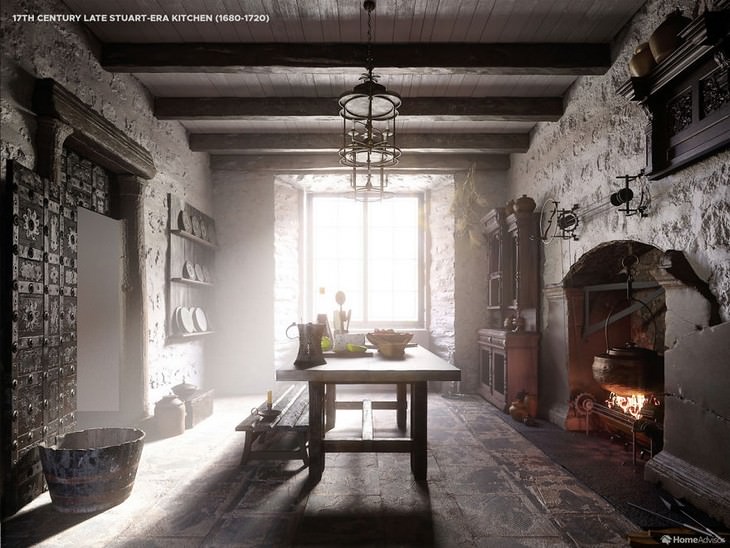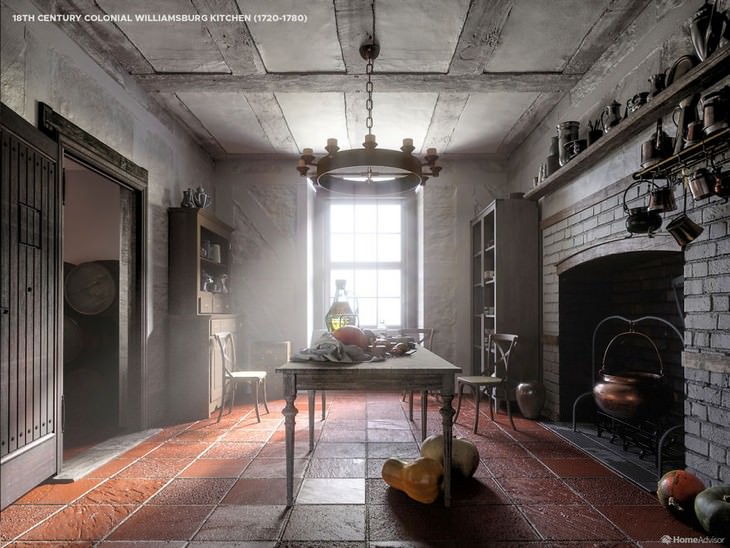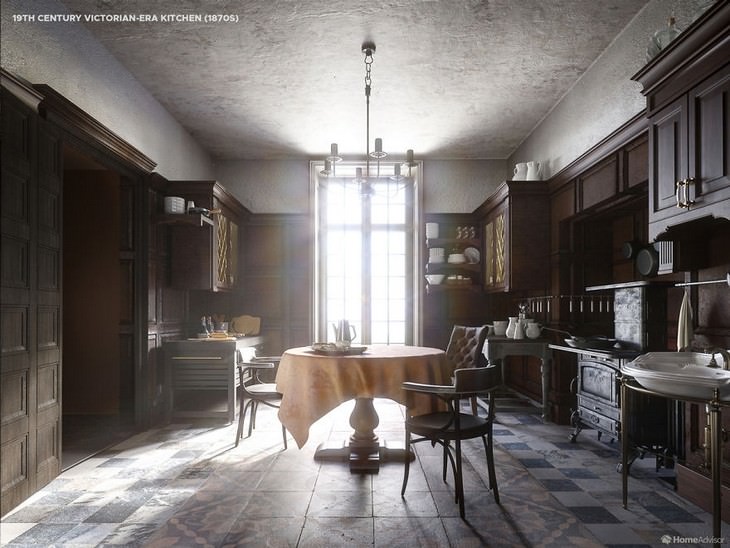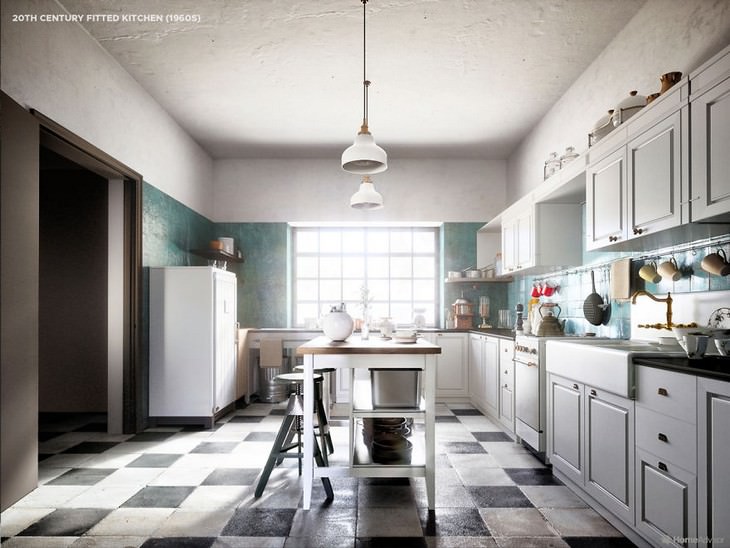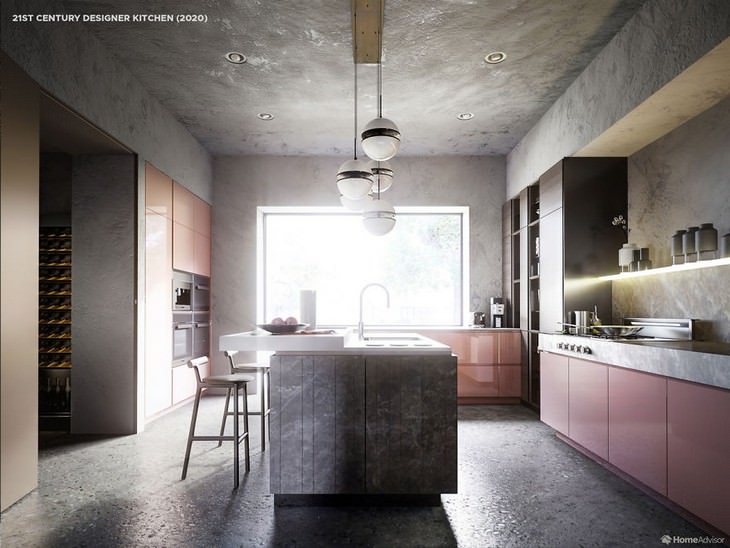1. 16th Century Tudor Manor Kitchen (1520-1620)
The fireplace had a very important role back then - it filled the role of a few later appliances combined. It was used for cooking and heating. The cauldron hanging from the pothook was most likely made of bell-metal (an alloy of copper and tin). Tucked behind the firewood rack, you can see the handles of utensils, such as a skimmer and a frying pan. The frying pan was common in all kitchens – the long handle would have protected users from the high flame.
Despite the fact that chimneys have existed for a long time in England, since 1185, it was only throughout the 16th century that they became widely used in most homes. The chimney made cooking a lot easier, as smoke was drawn up and out of the great hall, making it easier to breathe and create large cooking fires in fireplaces.
2. 17th Century Late Stuart-era Kitchen (1680-1720)
During the 17th century, ceramic teacups and teapots became widespread in urban homes, and as a result, the kitchen dresser also gained huge popularity. Even modest English households would store and display decorative ceramics on kitchen dressers and mantelpieces during this period.
The hearth has come a long way in a few decades - note the cast iron coal grate in place of the wood fire. And what about this new feature hanging above it? It is a mechanical roasting jack. The cook would wind it up and leave the pulleys and weights to turn the spit in the hearth for around half an hour without the need for manual labor.
3. 18th Century Colonial Williamsburg Kitchen (1720-1780)
This is the first American kitchen in the series. This kitchen would be located in Williamsburg, the capital of the Virginia colony for most of the 18th century. Because of the city’s wealth and prosperity, this kitchen is a bit fancier than the typical kitchen in the rest of the country at that time. Increased trade between Europe, the Americas, and Asia brought new foods and new demands to the kitchen.
The hearth is still of great importance, and Chimney sweeps were vital in keeping the hearth in excellent condition, despite the dangerous health issues associated with the work. The stack barrels at the doorway were a common way to store flour and other food at the time, and the shelves are full of practical (rather than decorative) pottery. The chairs, which did not appear in the earlier photos, suggest that the room is also used as a space for gathering later in the day.
4. 19th Century Victorian-era Kitchen (1870s)
Ah the Victorian era, what a time of great advancements! As you can see, the freestanding wood or coal oven was finally introduced. The oven’s stovetop saved fuel and also saved the cook from crouching. Another invention that seems so obvious to us today made its first appearance in those days - the kitchen clock! For the first time, cooks could precisely time their work.
More proof of how far we’ve come is the kitchen sink on the right side of the oven. Kitchen plumbing had also arrived, though the sink was more like a furniture object than an integrated utility at this point. The cupboards are a precursor of the two-in-one cupboard-and-shelves unit that was first marketed in 1899.
5. 20th Century Fitted Kitchen (1960s)
Nearly a century later, the kitchen was completely revolutionized. The 1960s fitted kitchen featured electrical appliances, an electric fridge and a gas cooker, which made life easier and shifted the balance of time and labor it took to feed a family.
Not only did cooking appliances themselves help the job - the laminated or painted surfaces made cleaning a whole lot quicker and simpler. The perimeter countertop in the center freed up social space and allowed the food prep to become part entertaining. Designing, buying, and using kitchenware were now expressions of consumer freedom and aspiration, according to the designers of Home Advisor.
6. 21st Century Designer Kitchen (2020)
Today we have pretty much every aid to make our life in the kitchen a breeze - as Home Advisor put it “Bright, clean, uncluttered kitchens rule the day in 2020". The exception is the island unit, which prioritizes sociability over clear access.
Across the kitchen, the simplicity and stylishness of industrial-style stainless steel and concrete meet strong, classic natural surfaces, such as marble, wood, or stone.
Bonus Video: The 500 Years Evolution of Kitchen Design


